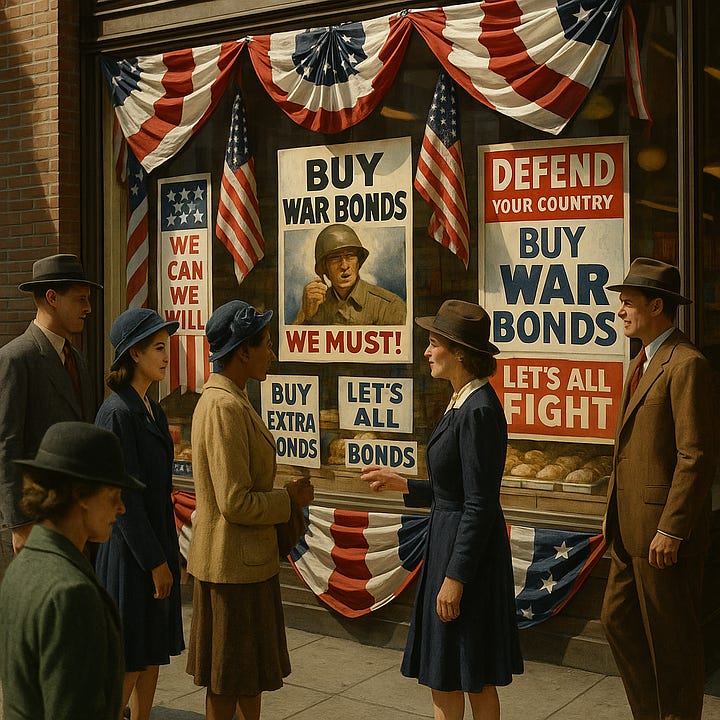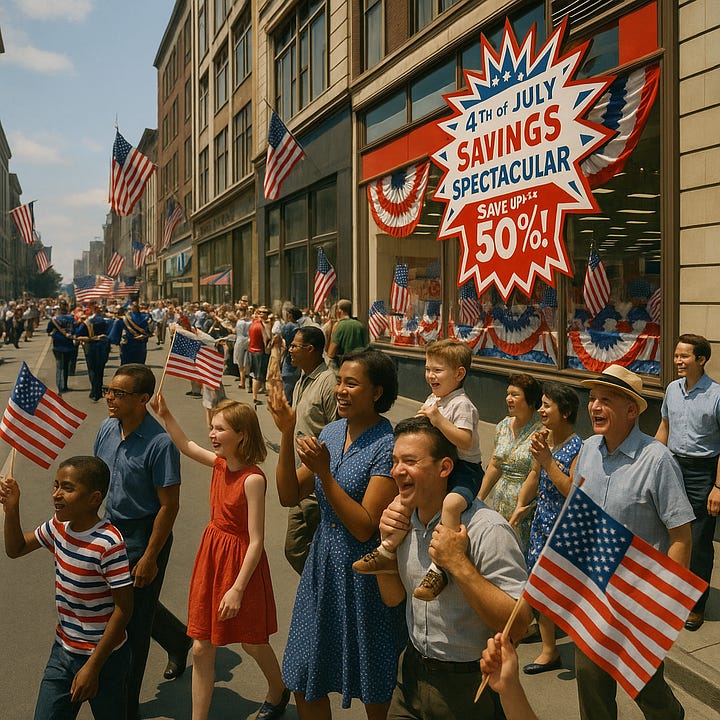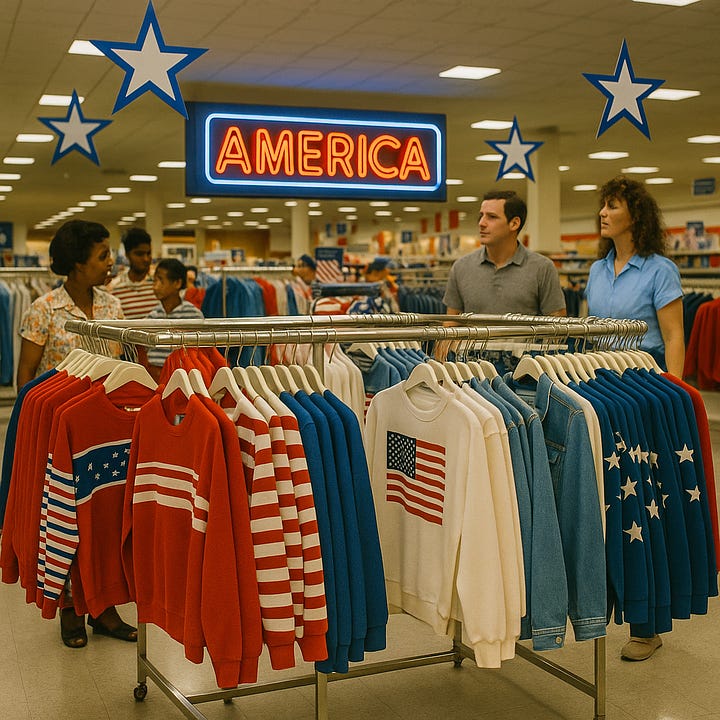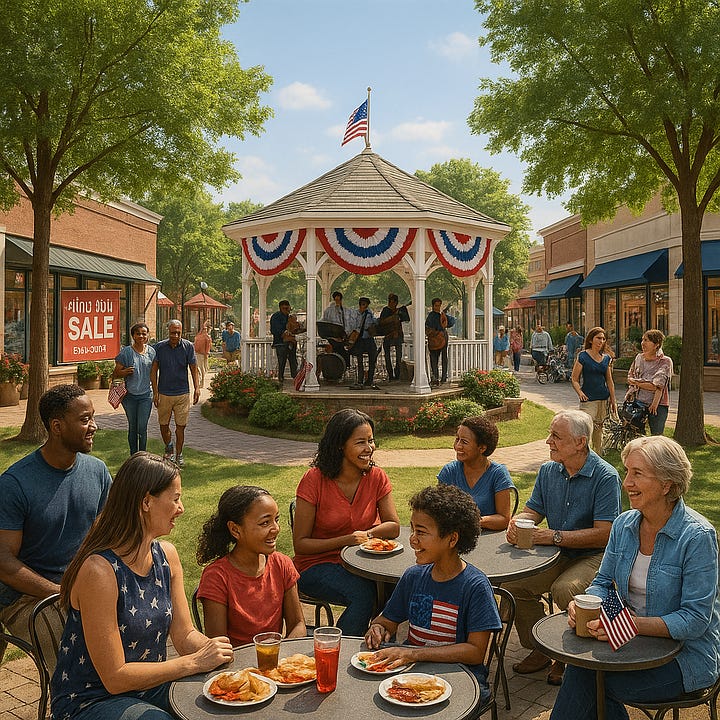🏷️ Stars, Stripes, and Shopping Carts: When Patriotism Became a Sales Strategy
From war bonds to weekend blowouts, retailers learned that nothing stirs urgency - or identity - like red, white, and blue.
Patriotism didn’t always come with a price tag.
But somewhere along the way, national pride found a partner in promotional pricing.
It started with unity.
And ended in urgency.




🇺🇸 Where did it begin?
Patriotism and commerce first formally united during war efforts.
In World War I and II, War Bonds weren’t just financial instruments - they were marketed with emotional storytelling: posters of Uncle Sam, slogans like “Buy a Bond, Beat the Axis,” and storefronts plastered in stars and stripes.
Retailers joined in, urging Americans to spend for the nation, not for themselves.
After the wars, the model stuck.
In the 1950s and 60s, patriotic advertising shifted from duty to desire. Automakers sold “freedom of the open road.” Cola brands sold “America’s real refreshment.” And department stores leaned into national holidays with taglines like:
“Celebrate your independence - with savings!”
👕 When patriotism became wearable
It wasn’t just the storefronts that got dressed up.
In the 1960s and 70s, American flag apparel first gained popularity - not in stores, but in protest. Musicians, anti-war activists, and counterculture figures wore stars and stripes to subvert establishment symbolism.
By the 1980s, that defiance became mainstream.
Ralph Lauren turned flag sweaters into aspirational Americana.
Old Navy made the $5 4th of July tee a family tradition.
And today, patriotic prints stretch across everything from socks to swimsuits.
The flag had become a fashion staple - both a celebration and, sometimes, a simplification.
🛍️ When remembrance became retail
As American life grew more commercialized in the post-war era, federal holidays began doubling as sales events.
Memorial Day, once solemn, became a high-volume weekend for car dealers and mattress stores.
Independence Day meant fireworks and family -but also deep discounts and fast fashion.
Even Veterans Day, rooted in honoring service, is now filled with “military appreciation” discounts.
Retailers, knowingly or not, recast civic rituals as consumer rituals.
And for many Americans, the rhythm of patriotism began to include what’s in the cart.
💡 Why did it work?
Because patriotism is emotionally immediate.
It taps identity, memory, and meaning.
And smart retailers know:
Emotions move faster than logic.
Red, white, and blue signal safety, tradition, optimism.
Tying those colors to a campaign evokes far more than just style - it signals trust and tribal connection.
But there's a line.
⚖️ When celebration blurs into consumption
Patriotism in commerce can unify - but also oversimplify.
When a holiday rooted in sacrifice, like Memorial Day, becomes a chance to save 20% on appliances, something gets lost.
When the flag becomes just another SKU, its meaning risks dilution.
We can love the cookouts, the parades, the sales - and still remember what they sit on top of.
🌟 The Echo Today
Patriotic marketing still dominates summer retail:
Flag-printed shorts, Americana aisles, and Star-spangled social media filters from major retailers brands.
But it’s also evolving:
Heritage brands like Levi’s, American Eagle, and L.L.Bean are weaving deeper American origin narratives - less about nostalgia, more about national identity with nuance.
Campaigns now aim to honor history without overstepping into gimmickry - a nod to both meaning and margin.
And in a polarized world, brands tread carefully:
Patriotism must feel grounded, not performative.
🕊️ What’s the lesson?
Patriotism can be a powerful sales tool - when it’s anchored in authenticity.
Done well, it connects shoppers to something bigger than the purchase.
Done poorly, it feels hollow - or even disrespectful.
Retailers don’t have to ignore the flag.
But they do need to remember what it stands for - before they print it on a pair of flip-flops.
🕰️ Echoes of Commerce




